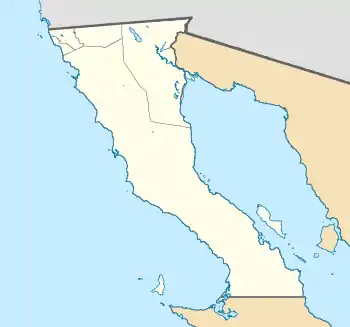San Quintín, Baja California
San Quintín is a coastal town on the west coast of the Mexican state of Baja California, in the Municipality of San Quintin, some 190 km (118 mi.) south of the city of Ensenada on Mexican Federal Highway 1. The town is also in the middle of an important agricultural area, especially for growing strawberries and tomatoes. The largest nearby locality is Lázaro Cardenas, home to 16,294 people as of the 2010 census. The whole area (6 localities) houses roughly 25,000 people, up from 20,000 in 2000. This is the largest population cluster south of Ensenada within the state.[1]
San Quintín | |
|---|---|
 | |
 San Quintín Location in Mexico  San Quintín San Quintín (Mexico) | |
| Coordinates: 30°33′37″N 115°56′33″W | |
| Country | |
| State | |
| Municipality | San Quintín |
| Area | |
| • Land | 14,263 sq mi (36,941 km2) |
| Elevation | 92 ft (28 m) |
| Population (2010) | |
| • City | 4,777 |
| • Urban | 4,777 |
| Time zone | UTC-8 (Northwest US Pacific) |
| • Summer (DST) | UTC-7 (Northwest) |
The coast also has many sand dunes, and is a popular place for off-road vehicles.
The town is on the west coast of the central Baja California Peninsula, near the Bahía de San Quintín, 300 km (187 mi) south of the San Ysidro–Tijuana international border along Federal Highway 1.
The Misión Santo Domingo de la Frontera lies 20 km north of San Quintín.
Business
San Quintin is home to the largest agricultural company in Baja California- Los Pinos.
History
In the 1880s, a British land company with plans for a wheat empire purchased much of the San Quintín area from the US–based International Land Company; at the time, ILC owned most of northern Baja. In response to promises of agricultural wealth, around a hundred English colonists purchased subdivided land tracts from the parent company, planted wheat, and constructed a gristmill. For flour transportation, the English built a pier on inner Bahiá San Quintín and began constructing a railway to link up with the Southern Pacific tracks to the north in California. Thirty kilometers of track were laid, including a rail causeway from the west bank of inner Bahiá San Quintín, before the colony failed. A 17-ton, six-wheeled locomotive still lies underwater at the mouth of the bay, the remains of a loading accident for the aborted railway.
A drought devastated one of the first wheat harvests, and by 1900 all the colonists abandoned San Quintín.
Remnants of the gristmill, the railroad causeway, the pier, and an English cemetery still stand along the perimeter of the inner bay. The English names on the cemetery's heavily weathered wooden crosses have faded from sight, and more recent Mexican graves are beginning to crowd out their neglected English counterparts.[2]
Recently there has been foreign (especially Chinese) investment in San Quintin for the development of shellfish harvesting and export (especially abalone). A tourist hotel is also planned.
San Quintin has been running an abalone conservation project, a project to repopulate depleted areas and prevent extinction. The conservation process involves farm growing abalone for two-three years and put back into its natural habitat. Farmers wait three years after that, and abalone is extracted for commercialization.[3]
On October 28, 2015 residents voted 17,580 to 7,548 in favor of San Quintin becoming its own municipality. On February 27, 2020 San Quintin separated from the municipality of Ensenada and became the state's sixth municipality.[4] The agricultural plain roughly 50 kilometers from Camalu to Vicente Carranza, recorded a total of roughly 80,000 people in 2010.
Climate
The temperatures tend to run warmer in summer and cooler in winter compared to San Diego, but out along the Pacific Ocean coastline about 5 miles west of San Quintin, the climate is virtually identical to San Diego's weather, year-round.
Aquaculture

In the realm of aquaculture, there are immense possibilities for growth. The extensive shoreline along the Pacific and the Sea of Cortes is in ideal condition, both biologically and economically speaking. The development and adaptation of aquaculture technology by Baja Californian institutions and the vocation of cultivating marine fish and mollusks have influenced the practice, making it a reality in present-day Baja California.
Due to the development in the cultivation of oysters, mussels and abalones, aquaculture has secured its place in the fishing industry and the demand for fishing products is increasing on a global scale. Baja California is a pioneer in the practice and at the forefront in aquaculture. Natural resources are at their maximum exploitation or have entered over-exploitation. Aquaculture has proved to be an answer to this crisis, as it is the area in the primary food sector where there are significant records of growth.
Fishing has become a tradition for many in Baja California, being distinguished worldwide for its high quality and variety. Business is conducted with distant locations such as Europe and Asia in addition to the United States and parts of Mexico. There is infrastructure in fisheries of all kinds, including technological, scientific, and specialized educational infrastructure.
Ensenada has many processing plants, canning machines, freezers, as well as fresh and live products, and gel production from seaweed. Several factories produce packages of different materials, such as tin cans, cardboard boxes, and extracted polyethylene packaging. The adjacent industrial areas in Baja California also facilitate the acquisition of equipment and spare parts.
There are shipyards and workshops to support the fishing industry as well as prestigious research centers for aquaculture that prepare students from a specialized secondary education, through technology programs in high school focusing on oceanography, to doctoral degrees in science.[5] Resources have increased substantially in recent years, considering the aquaculture industry in Baja California began just two decades ago.
To date, significant progress has already been made, with the greatest development being the cultivation of the oyster in San Quintín, with Ostiones Guerrero, SA de CV being the oldest and largest producer of both Pacific Gigas and Kumamoto oysters in Bahia Falsa and home to La Ostionera, its signature restaurant on the bay where locals and tourists alike come to enjoy fresh oysters and other "mariscos". The local oyster harvests produce over 1000 tons annually as well as mussels, abalone and other local species. The Bahia Falsa is certified by the Food and Drug Administration of the United States which guarantees the quality of the products and facilitates the commercial concurrence to the markets of that country.[6]

Recently, Ostiones Guerrero, SA de CV signed a collaboration agreement with Stellar Biotechnologies of Port Hueneme, California to grow giant keyhole limpets (megathura crenulata) at their aquaculture facilities at La Chorera, constructed for abalone farming. Under this collaboration, the animals will be grown for the extraction of a rare blood protein from the limpets called KLH, used in immunotherapy treatments of cancer, lupus, Alzheimers and in early stages of clinical trials for treatment of diabetes.
In addition to the natural wealth and the relative absence of pollution, it shares a border with a California, an important market. The most diverse shipments of seafood from Baja California cross the international border between Tijuana, B.C. and San Diego, California. The Los Angeles International Airport (LAX) is located 138 miles from the border with Mexico. From there, regular shipments of live fish and fresh seafood are made, using a route from the Baja California fishing fields ending at the Tsukiji fish market in Tokyo, Japan.
Towns
Lázaro Cárdenas, Baja California
- Colonia Vicente Guerrero
- a town north of San Quintín. It is located at (30°43′33″N 115°59′20″W) (population 11,455)
- El Socorro
- A small town between San Quintín and El Rosario. It is located at (30°18′57″N 115°49′10″W) (population 7). In the vicinity of this town was a salt marsh area which was the home of the likely extinct tule shrew and the San Quintin kangaroo rat.
- Poblado La Chorera
- a small fishing village located on the coast west of San Quintin and a favorite weekend getaway for local families to enjoy clean sandy beaches, tide pools and great surf fishing. La Chorera is also home to the abalone farm owned and operated by Ostiones Guerrero, SA de CV and is located at (30°27′41″N 116°02′23″W)
Transportation
By land, San Quintín is communicated by the Federal Highway 1, which runs from Cabo San Lucas to Tijuana. By air, the San Quintín Valley is served by severals airstrips:
- Campo de Lorenzo Skypark
- Cielito Lindo.
- El Buen Pastor Airstrip
- El Pedregal.
- Los Pinos.
- Rancho Magaña.
The San Quintín Airport is the only paved airstrip in the valley, but is a military field, so it is used for military aviation purposes only. The closest airports of entry are Ensenada and Tijuana.
Media
Valle de San Quintin on facebook, is a very popular online source for latest news, events and weather. https://web.facebook.com/ValleSanQuintin/
XEQIN-AM, a government-run indigenous community radio station that broadcasts in Mixtec, Zapotec and Triqui, is based in San Quintín. The Coatecas Altas Zapotec dialect is spoken in the surrounding areas.[7]
References
- "Baja California (Mexico): Municipalities & Localities - population statistics and maps". Citypopulation.de. 2011-03-07. Retrieved 2014-07-23.
- "SAN QUINTIN History Overview - San Quintin, Baja California, Mexico". Bajaquest.com. Retrieved 2014-07-23.
- "CROSSING SOUTH: San Quintin: Seafood farming". Retrieved 12 August 2020.
- Colon, Brenda (2013-06-29). "Baja California deems San Quintin it's [sic] own City - Noticias". SanDiegoRed. Retrieved 2014-07-23.
- "FAO Fisheries & Aquaculture National Aquaculture Sector Overview (NASO)". www.fao.org. Retrieved 2017-03-04.
- "Interstate Certified Shellfish * Shippers List" (PDF). www.fda.gov.
- "Coatecas Altas Zapotec (zca)". Summer Institute of Linguistics in Mexico. Retrieved 2014-03-11.